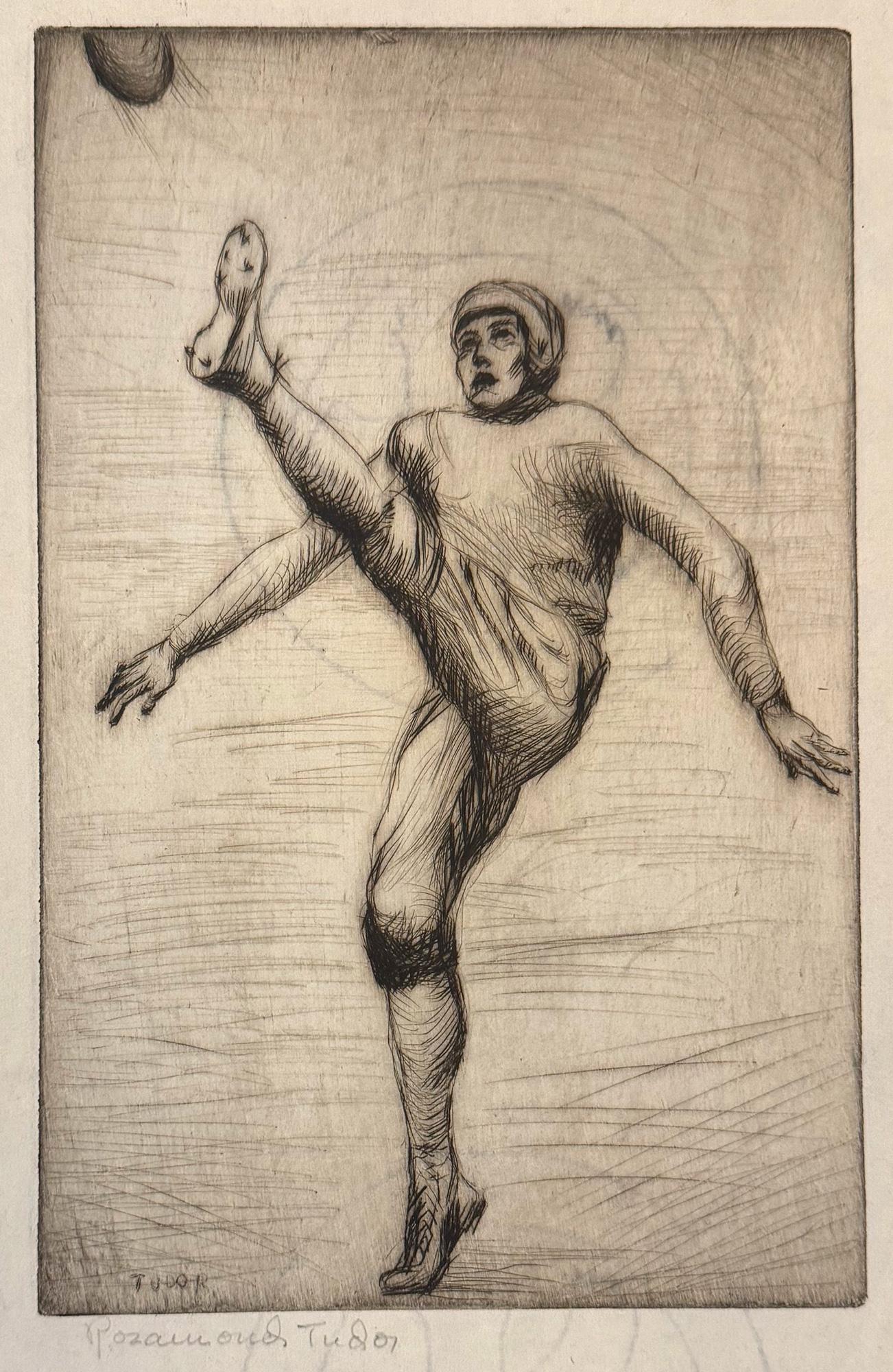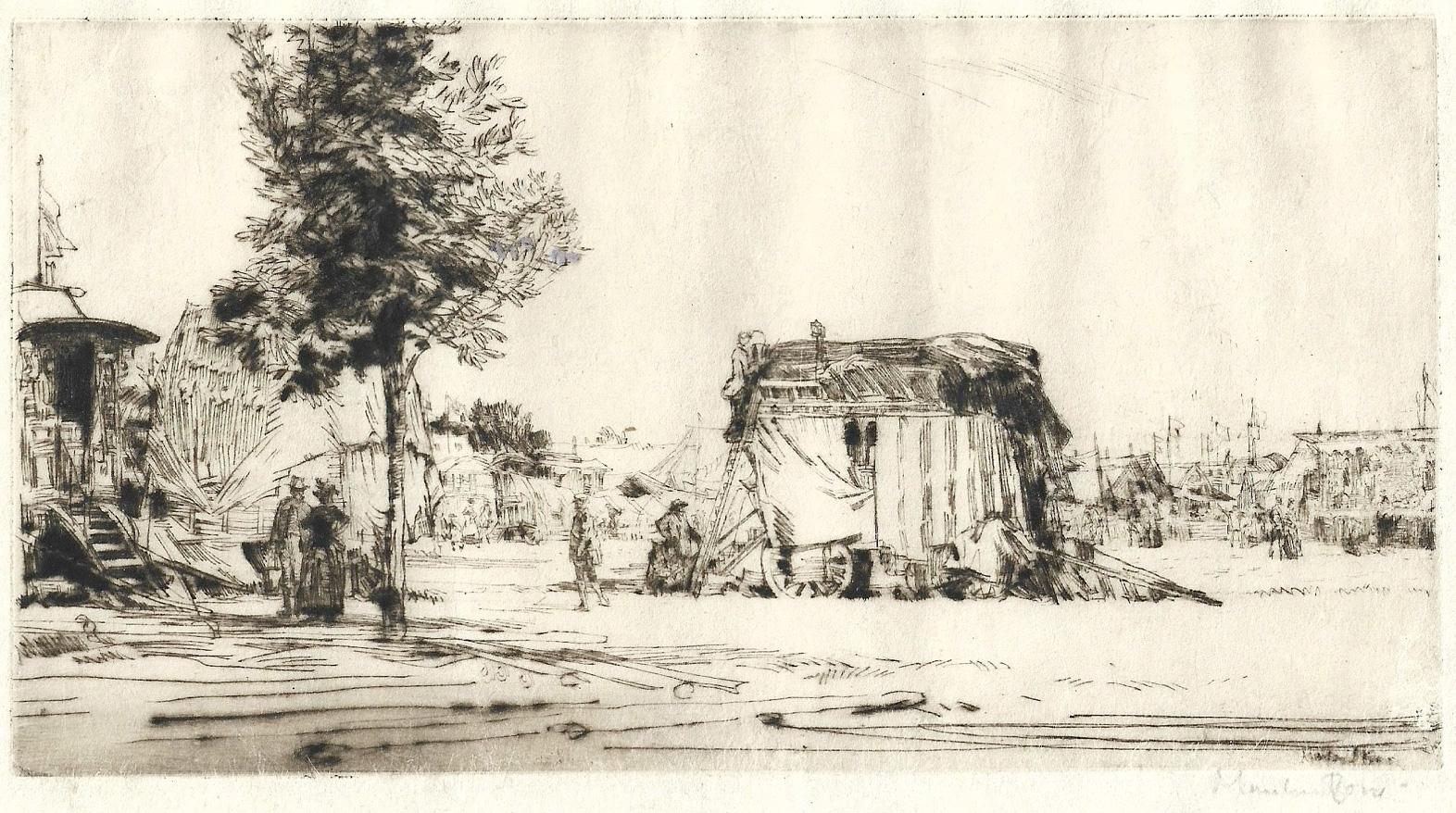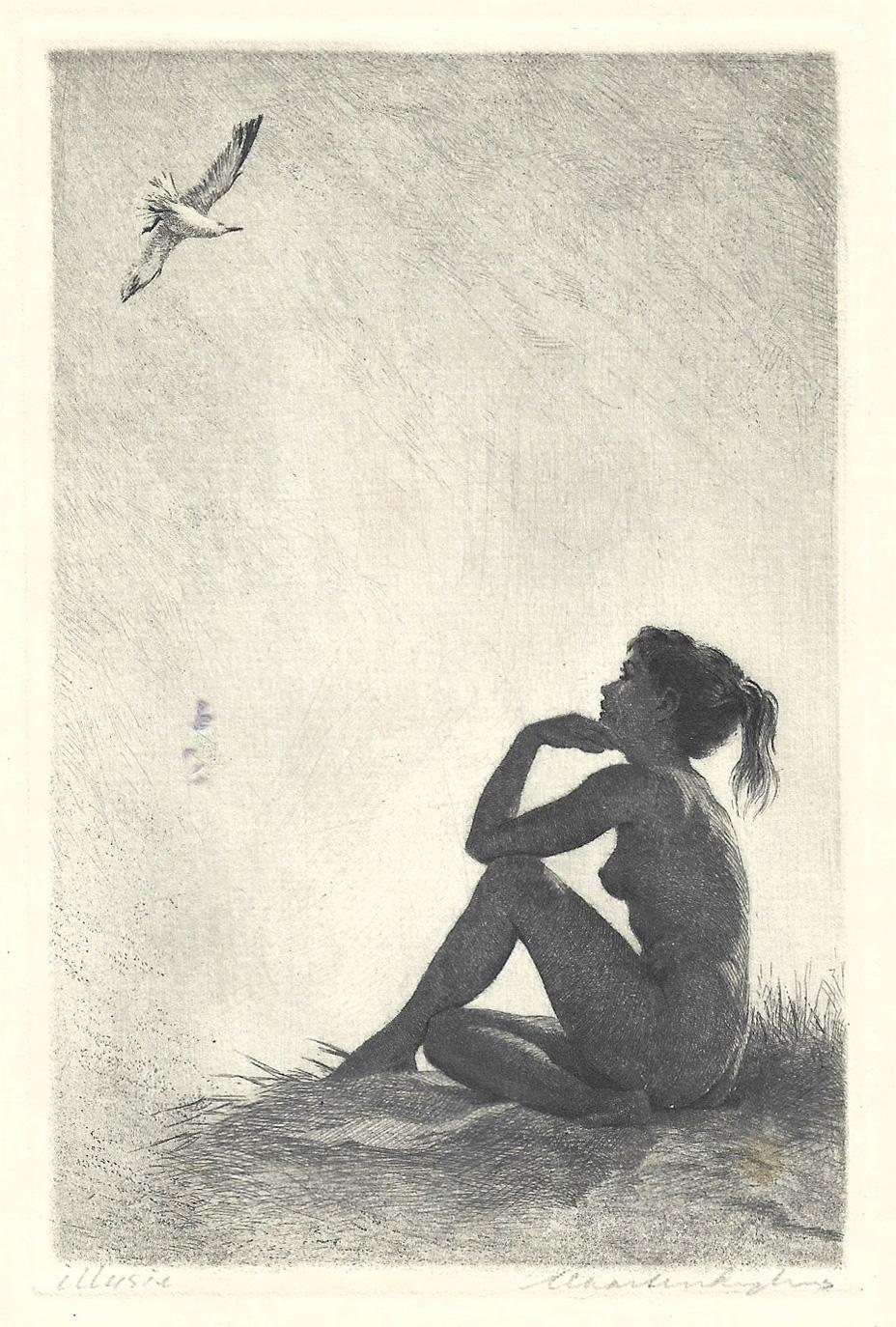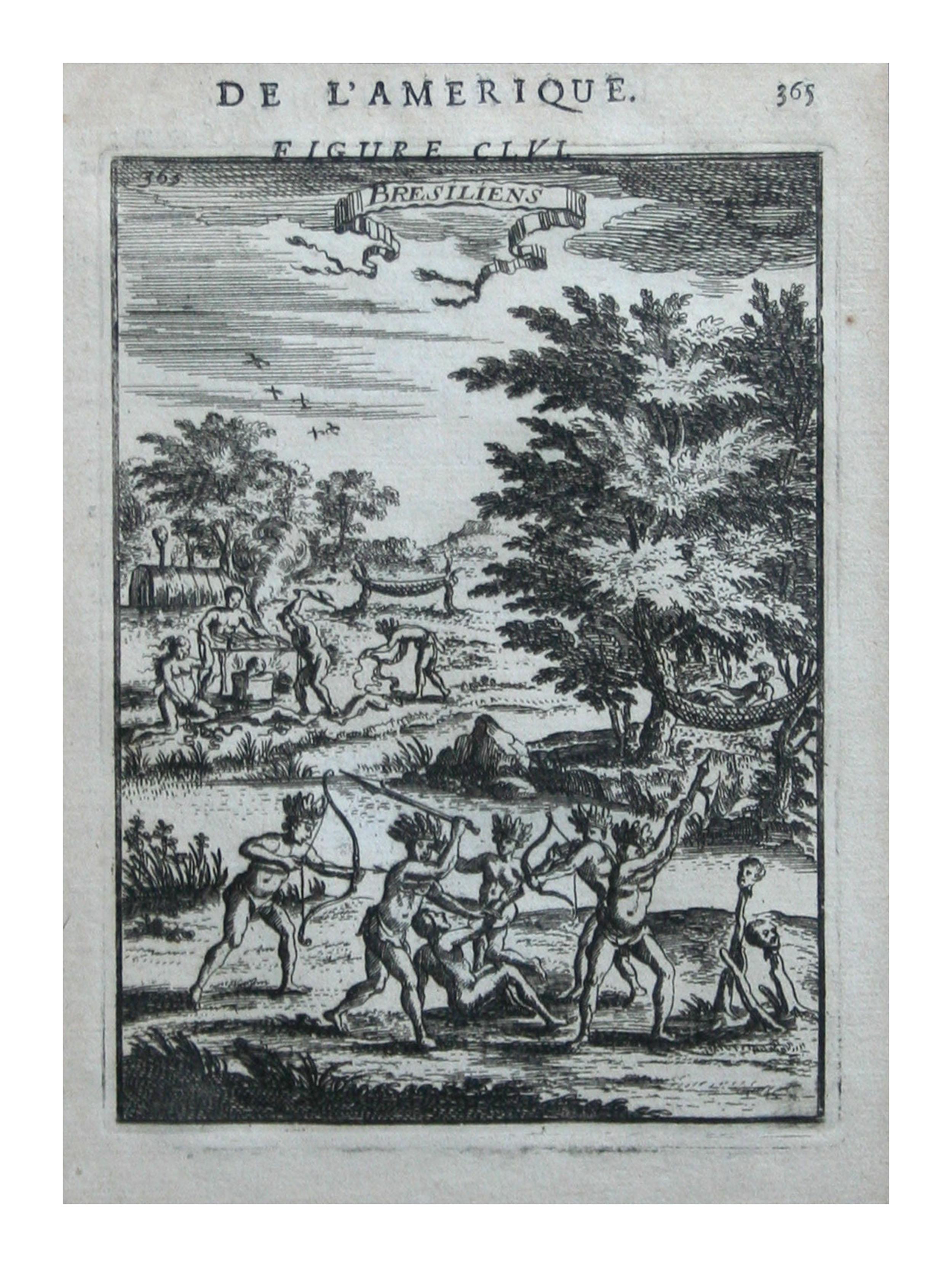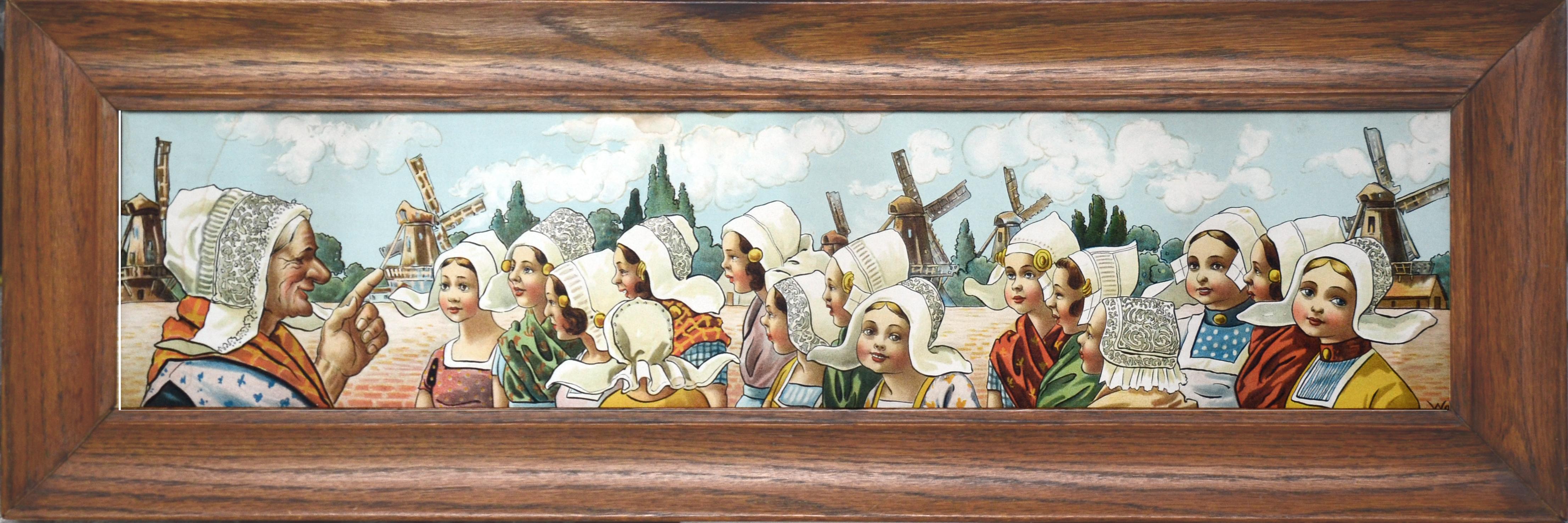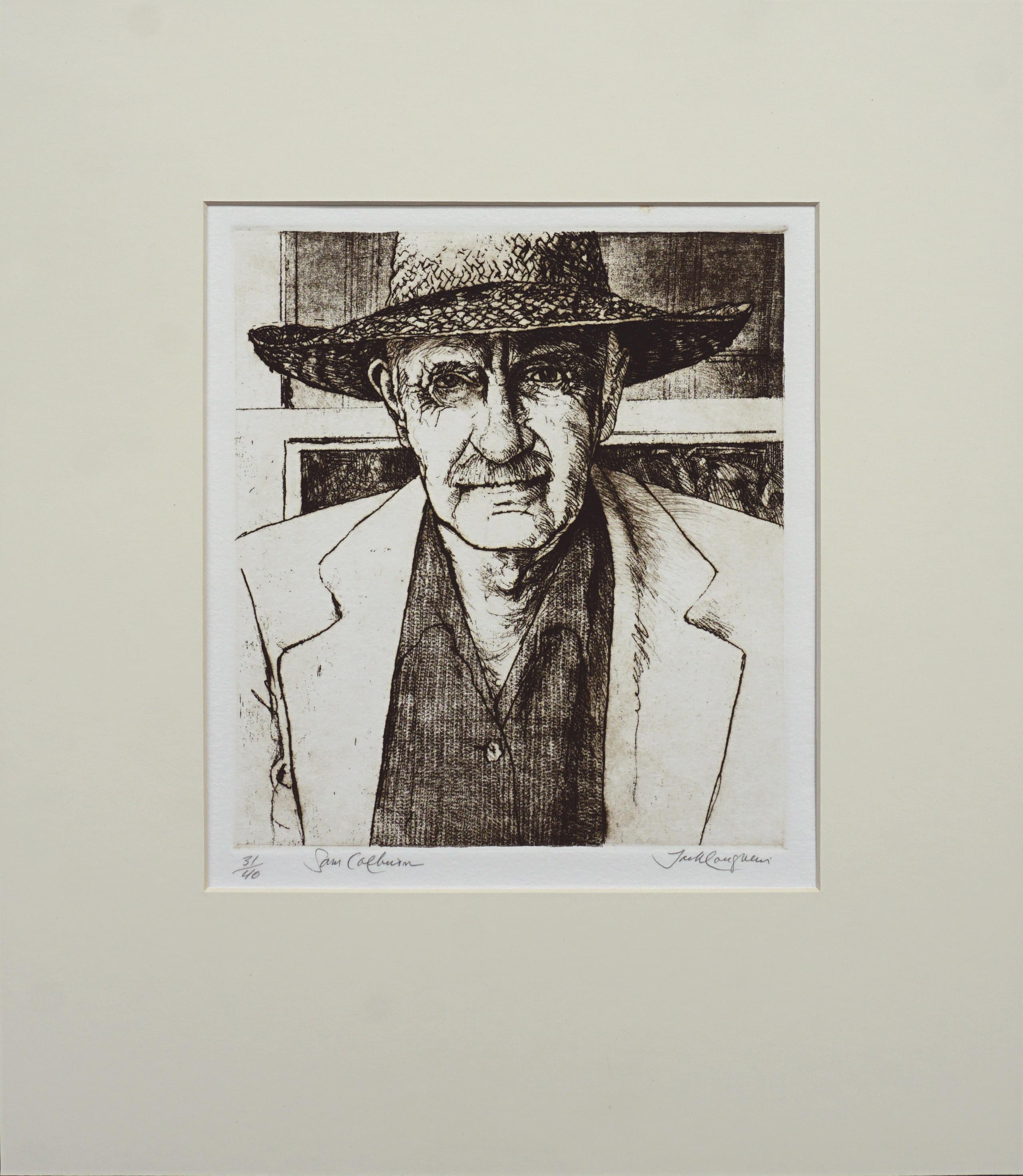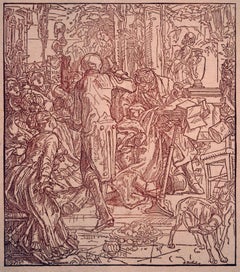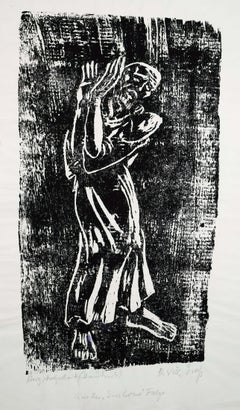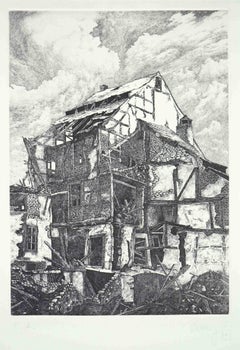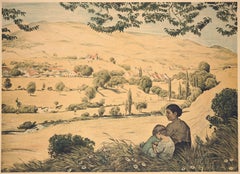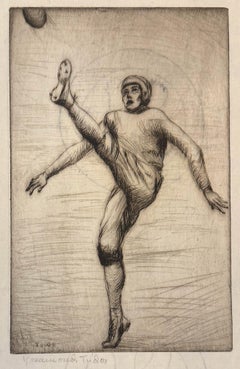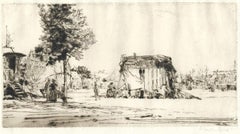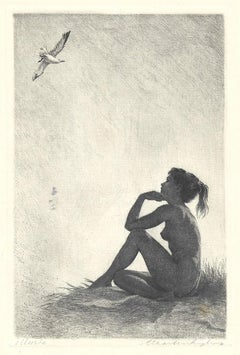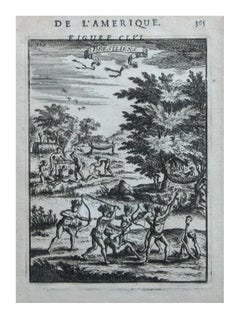Items Similar to Muse with Radio / - Modern twitter -
Want more images or videos?
Request additional images or videos from the seller
1 of 4
Werner KlemkeMuse with Radio / - Modern twitter -
About the Item
Werner Klemke (1917 Weißensee - 1994 Berlin), Muse with Radio, 1969. Wood engraving on Japanese paper. 17.5 cm x 8 cm (image), 23.5 cm x 12.5 cm (sheet size), with signed and dated dedication in pencil and artist's stamp
- mounted, minimally light-stained, otherwise in excellent condition
- Modern twitter -
Kalliope, the muse of poetry, is sitting on a park bench in an Arcadian landscape. But instead of reading the book she is holding in her hand, she is listening to the radio, holding the transistor radio directly to her ear so that she is completely absorbed by the sounds and no longer notices the book. The irony of the antique motif is heightened by the chirping of birds, which also cannot compete with the music coming from the radio.
Klemke uses "sacred" motifs from art history in order to turn them into irony through a reference to the present and thus ironize his own time.
About the artist
Walter Klemke, who initially worked as a cartoonist, was interned in East Frisia near Norden after the Second World War, where he had the opportunity to learn the technique of lithography. In the summer of 1945, Klemke designed the Bremen Town Musicians, the first children's book to be published after the war. After returning to Berlin in 1946, he produced illustrations for various magazines. His first major commission, the more than one hundred woodcut illustrations for Georg Weerth's 'Humoristische Skizzen', published by Volk und Welt in 1948, led to his artistic breakthrough and a never-ending series of commissions. In addition to his other artistic activities, Klemke illustrated well over 800 book titles. For his graphic work, he revived the almost forgotten technique of wood engraving, in which the hard, cross-cut end grain serves as a printing plate.
In 1951 Klemke became a lecturer at the Hochschule für Bildende und Angewandte Kunst in Weißensee, where he was appointed professor of book graphics and typography in 1956. A trip to China in 1954 led to an interest in Chinese woodblock prints. In 1956 Klemke co-founded the bibliophile Pirckheimer Society, for which he designed the logo. A member of the Akademie der Künste since 1961, Klemke became its secretary in 1964 and had to take on more and more bureaucratic tasks, which limited his artistic work.
A large number of solo exhibitions were dedicated to Werner Klemke, and he was involved in numerous important group exhibitions; his works were shown from the Third German Art Exhibition in 1953 to the Xth Biennale in Venice in 1959.
GERMAN VERSION
Werner Klemke (1917 Weißensee - 1994 Berlin), Muse mit Radio, 1969. Holzstich auf Japanpapier. 17,5 cm x 8 cm (Darstellung), 23,5 cm x 12,5 cm (Blattgröße), mit signierter und datierter Widmung in Blei und dem Künstlerstempel versehen
- montiert, minimal lichtrandig, ansonsten in ausgezeichnetem Zustand
- Modernes Zwitschern -
In einer arkadischen Landschaft sitzt auf einer Parkbank die Muse der Dichtung Kalliope. Doch anstatt das in der Hand gehaltene Buch zu lesen, hört sie Radio und hält das Transistorgerät dabei direkt ans Ohr, so dass sie von den Tönen ganz erfüllt ist und das Buch gar nicht mehr gewahrt. Verstärkt wird die Ironisierung des antikisierenden Motivs durch die umherfliegenden zwitschernden Vögel, die ebenfalls nicht mit der dem Radio entströmenden Musik konkurrieren können.
Klemke bedient sich hier ‚heiliger‘ Motive der Kunstgeschichte, um sie durch einen Gegenwartsbezug ins Ironische zu wenden und damit die eigene Zeit zu ironisieren.
zum Künstler
Zunächst als Trickfilmzeichner tätig, wurde Walter Klemke nach dem Zweiten Weltkrieg in Ostfriesland bei Norden interniert, wo sich die Gelegenheit ergab, die Technik der Lithographie zu erlernen. Daraufhin gestaltete Klemke mit den ‚Bremer Stadtmusikanten‘ das im Sommer 1945 erste nach dem Krieg erschienene Kinderbuch. 1946 wieder nach Berlin zurückgekehrt, fertigte er für verschiedene Zeitschriften Illustrationen an. Der erste große Auftrag, die mehr als hundert Holzstichillustrationen zu Georg Weerths 1948 im Verlag Volk und Welt erschienenen ‚Humoristischen Skizzen‘, führten zum künstlerischen Durchbruch, der eine nicht abreißende Folge an Aufträgen mit sich brachte. Neben seinen sonstigen künstlerischen Tätigkeiten illustrierte Klemke weit über 800 Buchtitel. Für seine grafische Tätigkeit hatte er sich die nahezu vergessene Technik des Holzstichs wiederangeeignet, bei dem das harte quergeschnittene Hirnholz als Druckplatte dient.
1951 wurde Klemke Dozent an der Hochschule für Bildende und Angewandte Kunst in Weißensee und dort 1956 zum Professor für Buchgrafik und Typographie ernannt. Eine 1954 erfolgte Reise nach China führte zur Beschäftigung mit dem chinesischen Farbholzschnitt. 1956 war Klemke Mitbegründer der bibliophilen Pirckheimer-Gesellschaft, deren Signet er entwarf. Seit 1961 Mitglied der Akademie der Künste, wurde Klemke ab 1964 als Sekretär zusehends für bürokratische Aufgeben herangezogen, die sein künstlerisches Schaffen beschnitten.
Werner Klemke wurden eine große Zahl an Einzelausstellungen gewidmet und er war an zahlreichen wichtigen Gruppenausstellungen beteiligt, so wurden seine Werke von der Dritten Deutschen Kunstausstellung 1953 bis zur X. Kunstausstellung der DDR 1988 gezeigt.

About the Seller
5.0
Gold Seller
Premium sellers maintaining a 4.3+ rating and 24-hour response times
Established in 2014
1stDibs seller since 2023
17 sales on 1stDibs
Typical response time: 6 hours
- ShippingRetrieving quote...Shipping from: Berlin, Germany
- Return Policy
Authenticity Guarantee
In the unlikely event there’s an issue with an item’s authenticity, contact us within 1 year for a full refund. DetailsMoney-Back Guarantee
If your item is not as described, is damaged in transit, or does not arrive, contact us within 7 days for a full refund. Details24-Hour Cancellation
You have a 24-hour grace period in which to reconsider your purchase, with no questions asked.Vetted Professional Sellers
Our world-class sellers must adhere to strict standards for service and quality, maintaining the integrity of our listings.Price-Match Guarantee
If you find that a seller listed the same item for a lower price elsewhere, we’ll match it.Trusted Global Delivery
Our best-in-class carrier network provides specialized shipping options worldwide, including custom delivery.More From This Seller
View AllDeath as a servant / - Concise congeniality -
Located in Berlin, DE
Alfred Rethel after (1816 Diepenbenden - 1859 Düsseldorf), Death as a servant, around 1920. Color woodcut by Oskar Bangemann after a drawing by Rethel created around 1845 on handmade...
Category
1910s Realist Figurative Prints
Materials
Paper
The Prophet / - The Burden of the Prophet -
Located in Berlin, DE
Wilhelm Gross (1883 Schlawe - 1974 Oranienburg-Eden), The Prophet, c. 1955. Woodcut on thin laid paper, 43 cm x 23 cm (depiction), 61 cm x 43 cm (sheet size), signed “Dr. Wilh.[elm] Gross” in pencil lower right, inscribed “Orig.[inal] Holzschnitt (Handabdruck)” lower left and inscribed “Aus der ”Ecce homo“ Folge” in the center.
- The wide margin with traces of pressing due to the impression, the sitter's left foot with a small purple stain, otherwise in vibrant condition.
- The Burden of the Prophet -
The large-format woodcut shows a prophet figure that takes up almost the entire height of the sheet. However, instead of seeing something in the distance that is still hidden from our eyes - as is usual in depictions of prophets - the figure has raised his hands in a defensive gesture, as if the prophet is trying to ward off what he has seen. At the same time, however, the position of the arms is an acceptance of the inevitable, which only those who recognize what is to come will have to bear for the time being, which is why the figure in the painting - despite its size - appears almost solitary, alone and exposed to the burden of suffering.
In a manner reminiscent of the folds of medieval wooden sculptures...
Category
1950s Realist Figurative Prints
Materials
Paper
Agony - The architecture of decay -
Located in Berlin, DE
Jörg Olberg (*1956 Dresden), Agony, 1987. etching, E.A. (edition of 30), 24 x 17 cm (image), 46 x 37 cm (sheet), each signed in pencil lower right "Olberg" and dated "IX [19]87", inscribed lower left "E.A. [Epreuve d'Artiste]".
- minimal crease and dust stains in the broad margin
- The architecture of decay -
About the artwork
Jörg Olberg draws here the sum of his artistic study of the Berlin ruins, which were still present in the cityscape well into the 80s. With his work "Agony" he creates an allegory of decay. Positioned in the landscape of ruins, a ruined house grows before the viewer, rising like the Tower of Babel into the sky, its roof and gable brightly illuminated by the sun. But already the roof shows mostly only the rafters, and as the gaze is drawn further down, the building visibly disintegrates, the beams protruding in all directions looking like splintered bones. Slowly but inexorably - in agony - the house will collapse in on itself and become nothing more than the burial mound of itself. At the same time, the small-scale stone composition and the plaster form a pattern-like ornamentation of decay.
The tension in the picture is fed by the counter-movement of growth and collapse, which is heightened by the dramatic formation of clouds. The swirls of clouds are reminiscent of a world landscape...
Category
1980s Realist Figurative Prints
Materials
Etching, Paper
$255 Sale Price
20% Off
Southern German summer landscape / - The profile of the landscape -
Located in Berlin, DE
Hans Thoma (1839 Bernau - 1924 Karlsruhe), Southern German summer landscape, around 1897. Algraph on strong wove paper, published by Breitkopf und Härtel in Leipzig as ‘Zeitgenössisc...
Category
1890s Realist Figurative Prints
Materials
Paper
At the pond / - The longing of the landscape -
Located in Berlin, DE
Hans Thoma (1839 Bernau - 1924 Karlsruhe), At the pond, 1897. Algraph on strong wove paper, published by Breitkopf und Härtel in Leipzig as ‘Zeitgenössisches Kunstblatt Nr. 148’, 23....
Category
1890s Realist Figurative Prints
Materials
Paper
S. Anton Patenkirchen / - The Home of the Landscape -
Located in Berlin, DE
Hans Thoma (1839 Bernau - 1924 Karlsruhe), S. Anton Patenkirchen, 1895. Algraph on strong wove paper, published by Breitkopf und Härtel in Leipzig as ‘Zeitgenössisches Kunstblatt Nr....
Category
1890s Realist Figurative Prints
Materials
Paper
You May Also Like
The Punt
By Rosamond Tudor
Located in Middletown, NY
A dynamic football image from the 1920s by a female artist known for her sports scenes.
Etching with drypoint on exceptionally fine laid Japon paper with a double watermark, 10 7/8 ...
Category
Early 20th Century Realist Landscape Prints
Materials
Handmade Paper, Drypoint, Etching
Cambridge Midsummer Fair
By Sir Muirhead Bone
Located in Middletown, NY
A peaceful image by Britian's first official war artist.
Drypoint printed in brownish black ink on fibrous, laid Japon paper, 3 3/8 x 6 5/16 inches (85 x 161 mm), full margins. Sign...
Category
Early 20th Century Realist Landscape Prints
Materials
Handmade Paper, Drypoint
Illusie
Located in Middletown, NY
Circa 1960. Etching and engraving on cream laid paper, 5 3/4 x 4 inches (141 x 102 mm), margins. Scattered light areas of spotty discoloration in the margins, minor mat tone. Four mi...
Category
Mid-20th Century Realist Nude Prints
Materials
Handmade Paper, Engraving, Etching
Native Civilians of America -- "De L'Amerique" Published Frankfurt / 1683
By Alain Manesson Mallet
Located in Soquel, CA
Wonderful etching, originally page 365 in a book De L'amerique by Alain Manesson Mallet, circa 1683, depicts the artist's concept of the appearance and activities of the native occupants of America in graphic detail. Unsigned. Displayed in a black and giltwood frame. Image, 6.5"H x 4.5"L.
1683 Manesson Mallet "Bresiliens" Amerindians, Indigenous Native Brazilians, Brazil, South America, Antique Print...
Category
1680s Realist Figurative Prints
Materials
Paper, Ink, Woodcut
Early 20th Century Dutch Girls Chromolithograph
Located in Soquel, CA
Charming early 20th century chromolithograph of young Dutch girls with their older instructor titled, "Dutch Girls" by Bernhardt T. Wall (American, 1889-195...
Category
Early 1900s Realist Figurative Prints
Materials
Paper, Ink
$280 Sale Price
20% Off
Sam Colburn Carmel Artist Portrait, Signed Limited Edition Realist Lithograph
By Jack Coughlin 1
Located in Soquel, CA
Highly detailed and realistic portrait lithograph of the modernist watercolor artist Sam Colburn (American, 1909-1993) by Jack Coughlin (American, b. 193...
Category
1980s Realist Portrait Prints
Materials
Paper, Ink, Lithograph
